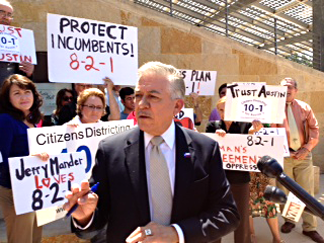Other proponents of alternative plans for geographic representation push their points

The passion and political experience of retired State Senator Gonzalo Barrientos (D-Austin) lifted the crowd of some 40 interested citizens who had come to hear a debate about what system should govern how Austin City Council members are elected.
Scene: A debate forum hosted by Southwest Key’s VOTA! Campaign at the organization’s headquarters in far East Austin.
Enter Barrientos: arriving 20 minutes after the program started and a bit flustered from being stuck in traffic.
When his turn to speak came, the former lawmaker drew on his storytelling ability to attack the council’s action to put the 8-2-1 plan (Proposition 4) on the same ballot with the citizens’ 10-1 initiative (Proposition 3).
“In the time of Christ,” he said, “there were two stores on the opposite side of a street. The owners didn’t like each other.
“One day an angel came down to visit one of the store owners and said, ‘I’ve been sent to grant you a wish.’”
The angel said he could grant the owner many children, a long life, or great wealth—whatever he wanted.
But, he warned that whatever the store owner wished for would be granted double to his enemy, the store owner across the street.
The store owner thought about it for awhile, then said to the angel: “Strike me blind in one eye.”
When the laughter finally died down, Barrientos posed a pointed question: Why did the City Council choose to offer a hybrid option (which was put on the ballot well after the Proposition 3 petition drive was ruled sufficient to get the 10-1 plan on the ballot)?
Barrientos implied the council’s motive was to figuratively “blind” Proposition 3.
In a follow-up interview, Barrientos made explicit the point of his story: “This is a method of killing the whole damn thing,” he said, a method to maintain the current at-large system and, with it, the status quo distribution of political power.
Barrientos was one of five speakers involved in this, the third, public debate concerning geographic representation held within a period of six days.
The other panelists lacked the senator’s storytelling ability and had to make do with the facts as they saw them.
Other Proposition 3 proponents were Austin NAACP President Nelson Linder and veteran political consultant Peck Young.
Proposition 4 panelists wereJulio Gonzales Altamirano, an Austin-based data-science and software consultant forUPD Consulting, and archaeologist Fred McGhee, PhD, of Fred L. McGhee and Associates Inc.
Barrientos chaired the council-appointed 15-member 2012 Charter Revision Committee on which Linder and McGhee also served.
8-2-1 proponents

Altamirano said that under a strictly geographic system of representation citizens may wind up with a council member they don’t agree with, and the at-large council members could provide constituent services those citizens might not otherwise be able to get.
Altamirano repeated what he said at the Gray Panthers forum on September 6, that a geographic representation system would “empower people I personally disagree with—conservatives—which is one of the trade-offs.”

McGhee based his initial remarks on a flier titled “Five Good Reasons Why You Should Support a Hybrid City Council,” prepared by Austin Community for Change. That group is backing the 8-2-1 plan for geographic representation that would have eight council members elected from geographic districts and the mayor and two council members elected at-large, that is, by all citizens casting votes.
“Austin likes choice,” McGhee said. “The gentlemen’s agreement has to go,” he said, referring to the arrangement established by power brokers in the 1970s that allowed a black and Latino to be elected under an all-at-large system. That system is still in place today.
“The hybrid (8-2-1) achieves change without being radical, reactionary,” he said. “Political fair representation is about more than geography.”
McGhee said the hybrid system is advantageous to African Americans, Asian Americans, and lesbians, bisexuals, gays, and transsexuals (LBGT), all of which are dispersed throughout the city.
The hybrid system, which is being used in Boston, Houston, and Corpus Christi, he said, would allow individual voters to cast ballots for four council members: the mayor, two at-large council members, and a district council member.
“This could be the last, best chance” to get voters to approve geographic representation, McGhee said, and he argued that the hybrid plan “stands the best chance of change we desire.”
10-1 proponents

Young noted that the 8-2-1 plan offered by Proposition 4 is the same plan that voters soundly rejected in the 2002 election.
A quick fact-check indicates he is correct: Proposition 3 in the May 4, 2002, election was defeated 58-42 percent. The ballot language for that election—“Shall the city charter be amended to provide for the election of eight members of the city council from single-member districts and two members of the city council and the mayor from the city at-large?”—is nearly word-for-word identical to the ballot language for Proposition 4 on the November 6 election ballot.
Young, who has been involved in Austin politics since 1969, said the coalition formed to support the 10-1 plan offered by Proposition 3 “is the biggest coalition I’ve ever seen” on the issue of geographic representation.
“Ours is the only plan that will let an independent commission draw the council districts,” Young said. “Their plan lets politicians draw districts, like the state Legislature—everyone who likes that system, stand up.” (For the record, no one did.)
“For 35 years I was paid to draw lines and I can draw lines like snakes,” he said, “but it’s not fair, it’s not right.
“We need a system (of drawing council districts) that benefits citizens—not who paid a consultant—and their system allows gerrymandering by the politicians drawing the lines.”
To those who foresee problems in possibly having to deal with an unresponsive city council member representing their geographic district, Young said that in the case of the Texas Legislature, “If you don’t like your state representative you go down the hall, and the same with county commissioners. That’s how geographic representation works.”

To those who argue that geographic representation isn’t needed because the City Council has had minority representation since 1971, Linder points to a list of issues that he says have not been addressed, including high unemployment and failing schools.
“Geographic representation allows minorities to elect their own people, people in East Austin who will address these issues.”
Linder points to the broad coalition of community groups that support the 10-1 plan, including “LULAC, Greens, and Republicans. It’s a very diverse coalition because we have something in common.” (To see the full list of endorsements, click here.)
He rejects the arguments put forth by 8-2-1 advocates on behalf of dispersed minority groups, like Asian Americans and the LBGT community, and offers a challenge: “If they can mobilize coalitions to get elected to the at-large council seats that they want, why can’t they do it in single-member districts?”
“We can pick and choose our representatives by building a coalition.”
Audience Q&A
After each side got its allotted 15 minutes to present the case for their proposition, the program was opened for questions that had been written down by audience members. The questions were put to panelists by emcee Daniel Llanes of the VOTA! Campaign.
Q: Who will draw council district lines under your plan?
Proposition 3: Young said an Independent Citizens Redistricting Commission would draw the lines in a process that starts with volunteers who wish to serve providing applications to the city auditor. The auditor will screen the applicants to establish a pool that meets the specified criteria to avoid conflicts of interest. A random drawing will select eight commission members, and those eight will then pick six more members from the same pool to ensure representation for minorities, women, and all parts of town. The commission will draw council districts as required by law.
For more information Young points to theordinance placing Proposition 3 on the ballot and the AGR website. (To access graphic illustrations that explain how the Commission would be formed and operate, see Austinites for Geographic Representation’s slides titled “The ABCs of the Independent Citizens Redistricting Commission.”)
Proposition 4: Altamirano said only, “TBD: To be determined.” To which Llanes replied, “By whom?” “That’s unclear,” Altamirano said. At that point McGhee stepped in and said, “Proposition 4 does not have a commission. “The commission precludes the City Council from doing something,” he said.
Q: In which scenario (proposition) do you see a person being elected from far southeast or deep East Austin under an at-large system?
Proposition 4: McGhee said, “How? That’s a political question. Minorities are elected under hybrid systems already,” he said, pointing to AISD Board of Trustees.
Proposition 3: Young said, “The answer is they will be elected if whites say so. I was there when the gentlemen’s agreement passed. Whites will let an African American and a Hispanic have a seat.” But the gentlemen’s agreement collapsed, he said, when Robert Barnstone was elected to a three-year term in 1988, soundly defeating the Latino choice, Sam Guzman, in a runoff. “If the minority candidate is not the one whites want, he doesn’t get elected.”
Q: Who sponsored or originated the 8-2-1 plan? Where did it come from?
Proposition 4: Altamirano answered, “The City Council.” He urged voters to look to the future and “think about what’s coming” from a demographic viewpoint.
Proposition 3: Young countered, “There’s no sense in projecting trends for 20 years. We’re talking about next year. African Americans can have a district with a plurality and have the opportunity to elect an African American in their own district. There will be two districts in which a Hispanic council member can be elected and by the end of the decade there should be three.” Under the at-large system the westside has dominated elections for 40 years and under the 8-2-1 plan they will dominate the at-large seats, he said.
Proposition 4: McGhee said, “It’s important to keep in mind the strong similarities between 8-2-1 and 10-1. Please don’t leave here thinking 8-2-1 is the enemy of change. Those who want no change at all support the gentlemen’s agreement.”
Q: Who’s behind 8-2-1? Who endorses 8-2-1, specifically?
Proposition 4: McGhee said, “Austinites for Geographic Representation spent more than a year gathering signatures, and the implication is our system is not supported. Let’s find out what the sentiment of the electorate is. We followed the democratic system and used our elected representatives, who placed 8-2-1 on the ballot. That is not an invalid approach to getting political change.”
Proposition 3: Young said, “There’s nothing invalid about putting 8-2-1 on the ballot, but they did it six weeks after RECA (the Real Estate Council of Austin) passed a resolution supporting it. The 8-2-1 plan lost by 14 points in 2002.” (Actually Proposition 3 lost by 16 points 58-42 percent, according to the City Clerk’s Election History website.) “Yet RECA passed a resolution supporting this decade-old, already defeated plan.”
“We got 33,000 signatures—not one of those council members who voted for 8-2-1 got 33,000 votes. (Fact check: Not everyone who signed the petitions to put Proposition 3 on the ballot will vote for it. As for the votes garnered by the five council members who put Proposition 4 on the ballot: Mayor Pro Tem Sheryl Cole came close, netting 32,395 votes in her 2012 reelection win. Mayor Lee Leffingwell got 25,446 votes in the same election. Among the three election winners in 2011—Council Members Laura Morrison, Chris Riley, and Kathie Tovo—none topped 24,000 votes.)
“We’ve got 30 endorsing organizations,” Young added. “They’ve got three,” he said, referring toAustin Community for Change endorsements.
Q: With the 10-1 plan, I will have 2 people to listen to me as a potential voter. I would have four listening to me under the 8-2-1 plan.
Proposition 3: Young said, “How many of the seven listen now? If you live in West Austin, it’s about six. If you live elsewhere that number can sag real fast.”
Proposition 4: McGhee said, “A fair political system is about more than geographic representation. … There are advantages in an at-large system: you can have geographic representation and dispersed populations can achieve electoral success.”
Q: how much has RECA donated to the 8-2-1 plan campaign?
Proposition 4: McGhee said, “None.” He went on to point out that Austinites for Geographic Representation has two major backers: Brian Rodgers of Rodgers & Reichle Inc., a commercial real estate firm, and Peoples Pharmacy (which is owned by Bill Swail, RPh). “Two-thirds of the money come from those two,” he said. “RECA gave us not a dime.”
Closing statements
Proposition 3: Young said the 10-1 plan is supported by 33,000 people, referring to the number of petition signers. “I ask you to remember than it’s a system that allows everybody to have a voice.
“We don’t need a little bit of change for the same people who have ran things for 41 years to have extra influence to override the power of minorities and neighborhoods. Let’s overturn the racist system we have now.”
Proposition 4: McGhee said of the gentlemen’s agreement, “Why do we still have this archaic thing? Has it been subjected to legal challenge? Yes, under the Voting Rights Act, and the outcome in federal courts found the gentlemen’s agreement is legal and in compliance with the Voting Rights Act—because in this city Anglos actually vote for people who are not Anglos. There are advantages to at-large.”
The forum was co-sponsored by ACLU, Austin Center for Peace and Justice, Austin Immigrant Rights Coalition, Austin NAACP, El Concilio, League of Women Voters Austin Area, MoveOn.org Austin Council, and LULAC (the League of United Latin American Citizens).
This report was made possible by contributions to The Austin Bulldog, which operates as a 501(c)(3) nonprofit to provide investigative reporting in the public interest. You can help to sustainThe Austin Bulldog’s reporting by making a tax-deductible contribution.
Related Bulldog coverage:
Proposition 3 Advocates Falsely Accuse RECA: Group alleges ‘rumor” of $100,000 pledge by Real Estate Council to defeat Proposition 3, but RECA says not so, September 12, 2012
No Change Option Surfaces in Ballot Debate: Former Council Member Bob Binder opposes both options on the ballot for geographic representation, September 11, 201
The Election Wars Have Begun: Interest in how council members elected running high, as face-off debates abound, September 9, 2012
8-2-1 Near Certain to Go on Ballot: City Council Votes on Second Reading to Put Competition Election Plan on Ballot, July 31, 2012
Hard Fought, Heartfelt Charter Decision: Charter Revision Committee Votes 8-7 to Back 10-1 Plan for Council Elections, February 3, 2012
New Restrictions Proposed for Lobbyist Fundraising: Lobbyists Can Only Give Candidates $25 But Can Collect Unlimited Contributions For Them, January 22, 2012
Committee Debates How to Elect Council: Charter Revision Committee Divided Over Pure Districts vs. Hybrid System, January 9, 2012
Thirteen Charter Changes and Counting: Charter Revision Committee’s Next Job: Tackle Plan for Geographic Representation, December 14, 2011
Council Confirms November 2012 Election Date for Charter Amendments: Resolution Ensures Citizens Initiative Won’t Force May 2012 Charter Election, November 3, 2011
Coalition Launching Petition Drive to Get on the Ballot for May 2012 Election, October 18, 2011
Broad Community Interest Focusing on How Mayor and Council Members Elected, October 4, 2011
Coalition Nearing Petition Launch for Grass-roots Council District Plan, August 24, 2011
Maps Prove Select Few Govern Austin: Forty Years of Election History Expose Extent of Disparity, August 4, 2011
Petition Launch Imminent to Force Election for Geographic Representation in City Elections, March 7, 2011







